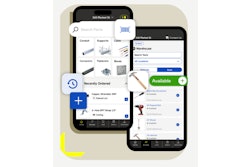
San Francisco-based Agora Systems, the leading provider of procurement management software for construction contractors, announced this week their new name—Kojo—and a raft of new functionality and support for new specialty contractor disciplines.
In a debriefing call with ForConstructionPros, Kojo Co-Founder and CEO Maria Davidson outlined how the company, which has according to a statement already grown year-over-year recurring revenue by fourfold, was now in a position to drive more purchasing and supply chain value to more construction disciplines.
The Kojo software functionality supports construction procurement processes from takeoff to closeout.
“Today, foremen across our customer base use the Kojo mobile app to create their requisitions—it gives them tools like pre-approved materials lists if a project has a spec or specific list of approved items,” Davidson said. “Also, we have a catalog of 400,000 parts that is categorized to make it easier to find what they need. Project managers use Kojo desktop to request a quote, making it easier and seamless to add multiple vendors so those vendors can upload availability and prices. Field teams also use us for delivery, to make sure what they ordered arrived. If not, they can use Kojo to notify the purchasing agent to fix it.”
Kojo also supports trade contractors in the planning of larger buyouts that help reduce unit prices and save money in the intermediate term.
“Many contractors are constantly buying materials but are not sure if they are getting the best deal,” Davidson said. “They are concerned about the cost of building inventory to support growth, and a lack of standardized process across projects … if we can help them save 10% on each buy-out of $200,000, that adds up.”
The software has standard interfaces with construction enterprise resource planning (ERP) packages ranging from ComputerEase, Viewpoint Vista and Viewpoint Spectrum (both now part of Trimble Construction One), Sage 300 Construction and Real Estate, Sage 100 Contractor, Quickbooks Online and Procore.
Procurement Software for More Subcontractors
“When we started, we were for electrical contractors only,” Davidson said. “Now, we are expanding into all major trades—mechanical, electrical, plumbing, concrete, drywall, glazing, roofing, flooring, self-performing general contractors. We are bringing to all trades the savings that our electrical contractor customer base has already been realizing.”
Kojo will have a large addressable market and should be within reach of most specialty contractors given that Davidson said the software is a fit for contractors ranging from $5 million in revenue up to about $1 billion.
“If they do commercial work, have a purchasing department and fall within the major trades we work on, we can help them gain control over procurement,” Davidson said. “We are constantly building products for more and more new trades.”
Accounts Payable, Project-Level Planning and Warehouse Management
New functionality makes the newly named Kojo a more complete and broader solution than was the case under the Agora name. Net new functionality includes:
- Accounts payable: To help contractors ensure they are paying right amount and reconcile their invoices with their delivery and order acknowledgements
- Project level planning: To track how they are doing against their estimates when it comes to funding versus quantities used
- Warehouse management: To confirm when a materials order has arrived in a warehouse, log what is coming in and going out and allocate specific materials to jobs as they are draw down
These functionalities may be available separately as non-construction specific products, but contractors may benefit more from industry-specific tools embedded in their procurement workflows.
“Most of our customers don’t want to use a generic warehouse management system (WMS),” Davidson said. “They are not built for contractors nor are they at a price point affordable to most of our customers. Our warehouse functionality is specifically built for trade contractors. Once they have done the initial setup, they can check materials directly into the warehouse.”
At this point the warehouse functionality is not supported by automated data capture like barcode scanning or radio frequency identification (RFID), but that may be on the roadmap according to Davidson.
“Our project level planning tool allows our customer to upload their bill of materials (BOM) and get real time visibility into how their spend tracks against the original BOM,” Davidson said. “The thing we heard time and time again is that they had little visibility into how much they are spending with different types of vendors, on different types of materials, or for different projects. Spend today is a black box and it is difficult to see if they spent the same amount compared to their estimate or compared to other projects. Contractors want to see at any moment how much they are spending. We track that in real time as they are submitting and placing their purchase orders, that then track it against the purchasing schedule. We are giving them the flexibility to set up project level planning, and if prices have been going up, they can purchase extra in advance. But a major thing for our customers is big buy outs, where they then want to track to see how much they are drawing down from that versus how much they expected.”
 Maria DavidsonKojo
Maria DavidsonKojo
Software Price and ROI
Kojo is sold on a subscription as a multi-tenant software-as-a-service (SaaS) product and is provisioned on Amazon Web Services (AWS). The subscription is priced based on contractor revenue combined with the number of products or modules. The subscription price includes implementation and training. Contractors can be up and running on Kojo pretty rapidly, ranging from a couple days to three weeks, with the biggest determining factor being the ERP package it has to integrate with.
“We have sales engineers who help the customer through the early stages, and then after the sales process, the customer gets handed off to an implementation manager, who makes sure integration validation is smooth. They we hand them off to a customer success manager,” Davidson said, stressing that every customer has a designated customer success representative.
The subscription cost can be liquidated by reductions in a number of internal and external cost centers.
“First, it is just monetary savings,” Davidson said. “How many of you frequently get multiple quotes before you buy? How far in advance do you buy? There are measurable benefits of doing buyouts further in advance. We can give examples of customers saving millions of dollars per year by doing larger buyouts, locking in pricing and getting multiple quotes from vendors. How much time do field teams spend chasing materials? And then there are office time savings—how much time is spent manually reconciling invoices? How much time do purchasing teams spend managing by phone and email and Excel? How much time does it takes to enter things back into your accounting system?”
Introducing modern efficiencies into procurement may also help contractors win the war for talent, according to Davidson.
“At a lot of the contractor teams we work with are trying to recruit people who grew up with computers in their pocket, using Amazon, and are used to being able to track when a delivery is happening. Kojo will help a contractor attract and retain these people who have modern expectations about how technology supports their work.”




















